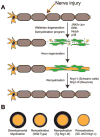Signals regulating myelination in peripheral nerves and the Schwann cell response to injury
- PMID: 23896313
- PMCID: PMC3830599
- DOI: 10.1016/j.conb.2013.06.010
Signals regulating myelination in peripheral nerves and the Schwann cell response to injury
Abstract
In peripheral nerves, Schwann cells form myelin, which facilitates the rapid conduction of action potentials along axons in the vertebrate nervous system. Myelinating Schwann cells are derived from neural crest progenitors in a step-wise process that is regulated by extracellular signals and transcription factors. In addition to forming the myelin sheath, Schwann cells orchestrate much of the regenerative response that occurs after injury to peripheral nerves. In response to injury, myelinating Schwann cells dedifferentiate into repair cells that are essential for axonal regeneration, and then redifferentiate into myelinating Schwann cells to restore nerve function. Although this remarkable plasticity has long been recognized, many questions remain unanswered regarding the signaling pathways regulating both myelination and the Schwann cell response to injury.
Copyright © 2013 Elsevier Ltd. All rights reserved.
Figures


Similar articles
-
Zeb2 is essential for Schwann cell differentiation, myelination and nerve repair.Nat Neurosci. 2016 Aug;19(8):1050-1059. doi: 10.1038/nn.4321. Epub 2016 Jun 13. Nat Neurosci. 2016. PMID: 27294512 Free PMC article.
-
mTORC1 Is Transiently Reactivated in Injured Nerves to Promote c-Jun Elevation and Schwann Cell Dedifferentiation.J Neurosci. 2018 May 16;38(20):4811-4828. doi: 10.1523/JNEUROSCI.3619-17.2018. Epub 2018 Apr 25. J Neurosci. 2018. PMID: 29695414 Free PMC article.
-
Neuregulin/ErbB Signaling in Developmental Myelin Formation and Nerve Repair.Curr Top Dev Biol. 2016;116:45-64. doi: 10.1016/bs.ctdb.2015.11.009. Epub 2016 Feb 1. Curr Top Dev Biol. 2016. PMID: 26970613 Review.
-
Neuregulin-1 type I: a hidden power within Schwann cells for triggering peripheral nerve remyelination.Sci Signal. 2013 Apr 9;6(270):jc1. doi: 10.1126/scisignal.2003945. Sci Signal. 2013. PMID: 23572145
-
Negative regulation of myelination: relevance for development, injury, and demyelinating disease.Glia. 2008 Nov 1;56(14):1552-1565. doi: 10.1002/glia.20761. Glia. 2008. PMID: 18803323 Review.
Cited by
-
Transcription factor SS18L1 regulates the proliferation, migration and differentiation of Schwann cells in peripheral nerve injury.Front Vet Sci. 2022 Aug 15;9:936620. doi: 10.3389/fvets.2022.936620. eCollection 2022. Front Vet Sci. 2022. PMID: 36046506 Free PMC article.
-
Hypoxia-Induced Upregulation of miR-132 Promotes Schwann Cell Migration After Sciatic Nerve Injury by Targeting PRKAG3.Mol Neurobiol. 2016 Oct;53(8):5129-39. doi: 10.1007/s12035-015-9449-y. Epub 2015 Sep 23. Mol Neurobiol. 2016. PMID: 26399639
-
Pard3 regulates contact between neural crest cells and the timing of Schwann cell differentiation but is not essential for neural crest migration or myelination.Dev Dyn. 2014 Dec;243(12):1511-23. doi: 10.1002/dvdy.24172. Epub 2014 Oct 1. Dev Dyn. 2014. PMID: 25130183 Free PMC article.
-
Oral granular cell tumor: a collaborative clinicopathological study of 61 cases.Oral Maxillofac Surg. 2024 Sep;28(3):1383-1397. doi: 10.1007/s10006-024-01272-9. Epub 2024 Jun 21. Oral Maxillofac Surg. 2024. PMID: 38904898
-
The repair Schwann cell and its function in regenerating nerves.J Physiol. 2016 Jul 1;594(13):3521-31. doi: 10.1113/JP270874. Epub 2016 Mar 21. J Physiol. 2016. PMID: 26864683 Free PMC article. Review.
References
-
- Sherman DL, Brophy PJ. Mechanisms of axon ensheathment and myelin growth. Nat Rev Neurosci. 2005;6:683–690. - PubMed
-
- Nave KA. Myelination and support of axonal integrity by glia. Nature. 2010;468:244–252. - PubMed
-
- Trapp BD, Nave KA. Multiple sclerosis: an immune or neurodegenerative disorder? Annu Rev Neurosci. 2008;31:247–269. - PubMed
-
- Suter U, Scherer SS. Disease mechanisms in inherited neuropathies. Nat Rev Neurosci. 2003;4:714–726. - PubMed
-
- Jessen KR, Mirsky R. The origin and development of glial cells in peripheral nerves. Nat Rev Neurosci. 2005;6:671–682. - PubMed
Publication types
MeSH terms
Grants and funding
LinkOut - more resources
Full Text Sources
Other Literature Sources

